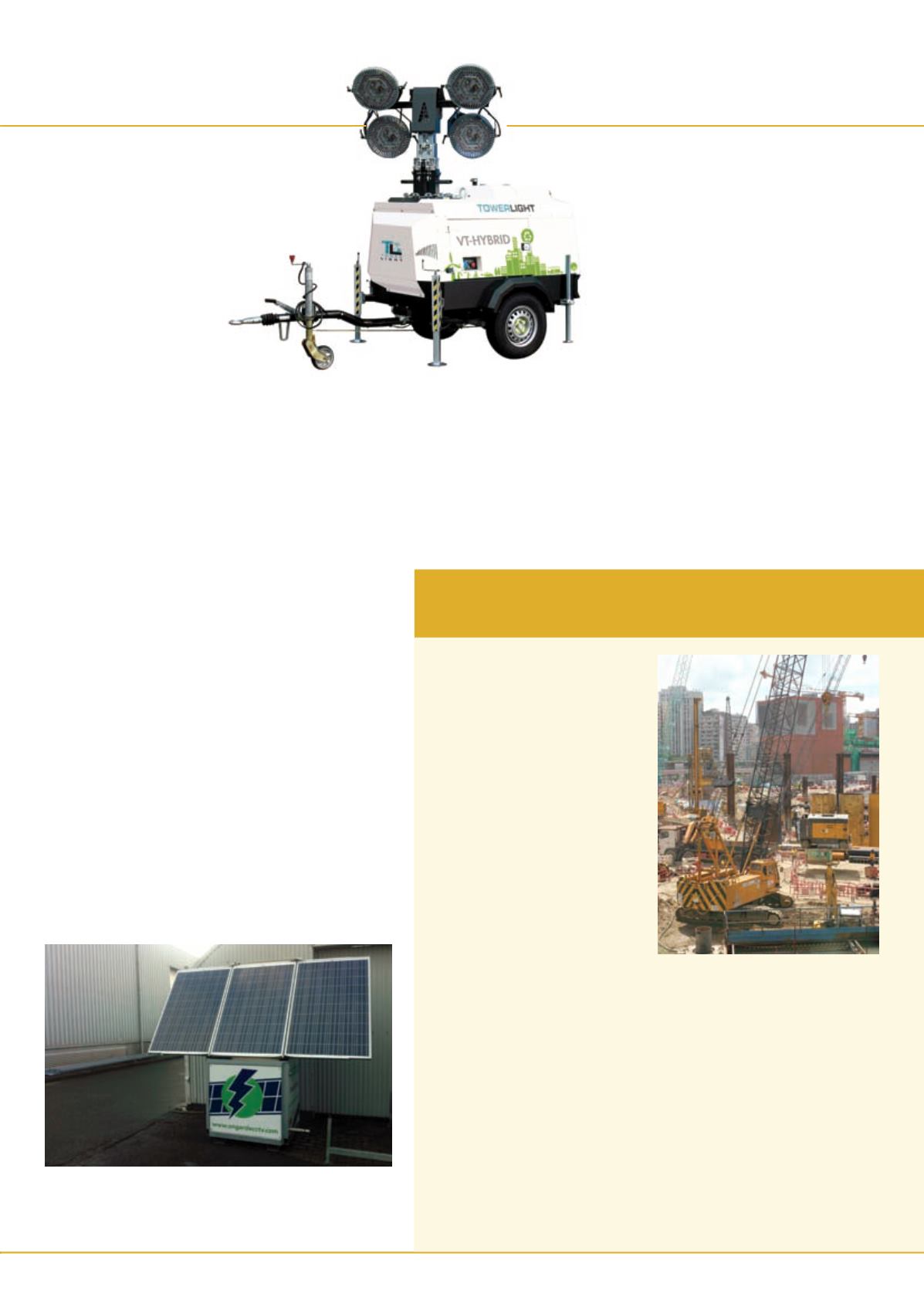
45
december 2013
international
construction
PORTABLE POWER
Power solutions
Energy Solutions’ managing director, Paul Holland said,
“Overall we have seen fuel savings of 30% to 40% and
an average of a one third reduction in running hours.
With figures like these we know the product will be
highly beneficial.”
ES Site Power is available in three power capacities
all with the option of sealed maintenance-free gel
batteries.
This type of hybrid approach is also finding traction
in the lighting tower market. This year saw UK-based
Tower Light launch its VT-Hybrid, which has a similar
hybrid engine/battery system that would typically run
the light for 8 hours on the generator (which also charges
the battery) and then 8 hours on the battery.
This means the system is silent for half the time and Tower Light
says fuel usage is so low that it can run for more than 500 hours
on a single tank of fuel.
The company estimates this can reduce costs by some UK£ 400
(US$ 650) per month and save over 1 tonne of CO² emissions
when using a VT-Hybrid instead of a traditional lighting tower.
Taking the concept even further, UK-based OnGarde now offers
a portable hybrid solar power station (HPS) for applications such
as powering site security cameras in remote locations. The stand-
There is a clear growth trend in the genset
and lighting tower business, and this
is drawing new manufacturers into
the sector and encouraging the
incumbents to spread their
wings.
JCB Power Products – the JCB
division that sells generators and lighting
towers – says it is poised for a major expansion
of its distribution network over the coming five years, with the
number of dealers expected to increase from the current 60 to
nearer 240.
Jonathan Garnham, who took up the post of director and
general manager of the business in January this year, said, “We’ve
learned about what is required to be a successful dealer in Power
Products. Globally, our dealers who have taken part have had
their eyes opened to the opportunity.”
As the company plans its expansion it is also growing its product
range, with new LED lighting towers being launched as well as
improvements to its range of generators, which are now using
new digital controllers.
JCB uses its own four-cylinder engines in around 15% to 20%
of its gensets – those in the 60 to 140 kVA range – and it intends
to incorporate the six-cylinder engine launched this year by the
third quarter 2014, taking the JCB-powered genset range up to
around 200 kVA. The full generator line comprises 114 models
from 8 to 2700 kVA, all of which are built by an unnamed third
party.
Hybrids
Another interesting new product for the construction industry
is the ES Site Power from Energy Solutions. This has been
designed to account for the issue that loads on generators vary a
lot throughout the day on construction sites.
The unit is a hybrid system including both batteries and a
generator. By day the generator runs as normal providing power
to the site and charging the batteries. At night the generator part
can be switched off, saving fuel and unnecessary engine hours,
with the batteries providing enough power for the reduced
requirements of the site. This also means noise is reduced at night,
which can be an important consideration.
Fitted with an engine, batteries and solar panels, OnGarde’s
portable hybrid solar power station (HPS) for powering
security cameras on remote sites can run for three months
between refuelling and servicing.
UK-based Tower Light launched a hybrid
lighting tower this year that runs silently
from batteries 50% of the time.
Digging deep
Compressors drive WKT foundation construction
T
he Hong Kong-based joint venture
Leighton-Gammon JV is currently
using more than 30 Atlas Copco
compressors in the construction of the
US$ 1.23 billion West Kowloon Rail
Terminus (WKT). WKT covers an area of 25
acres (10 ha), and will be predominately
built underground. With 15 platforms and a
design to handle some 100,000 passengers
per day, the completed WKT is expected
to be the largest terminal of its type in the
world.
Construction requires 1.7 million m
3
of
open cut excavation to a depth of 33 m,
and the use of 600,000 m
3
concrete and
150,000 tonnes of steel. This equates to
an excavation of approximately 5,000 m
3
of earth per day, or 800 truckloads. The
terminus will be surrounded by pile wall of about 500 m
3
diameter bored piles sunk to a depth
of 40 m, along with 5,000 H-section piles.
The contractor is sinking bored piles using reverse circulation piling rigs with two or three
Atlas Copco compressors per rig. According to Gammon’s equipment manager, Cheng Chung
Heung, “A key requirement for today’s drilling is high air pressure and for this we have turned
to Atlas Copco, taking delivery of more than 150 Atlas Copco compressors in the past 18
months. They all perform very well in terms of air power output for reverse circulation drilling
(RCD) and down the hole (DTH) applications. The company also has a strong back up servicing
and technical support in Hong Kong.”
One of the main compressors used on-site, the XRHS 1096, has been developed to supply
air at 1078 cfm (30.5 m
3
/min) at a pressure of 20 bar. “This free air delivery, air pressure and
fuel economy make the XRHS1096 the most popular compressor for contractors,” explained
Raymond Ng, sales engineer with Atlas Copco Portable Energy in Hong Kong.
Other compressors used on site include the XRHS 506, which also delivers 20 bar pressure
with an output of 1059 cfm (30 m
3
/min), and the XRS 846 and XRS 396, which both deliver 830
cfm (23.5 m
3
/min) at 17 bar.
>


